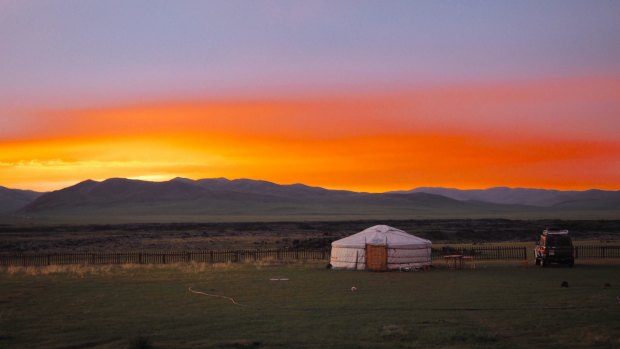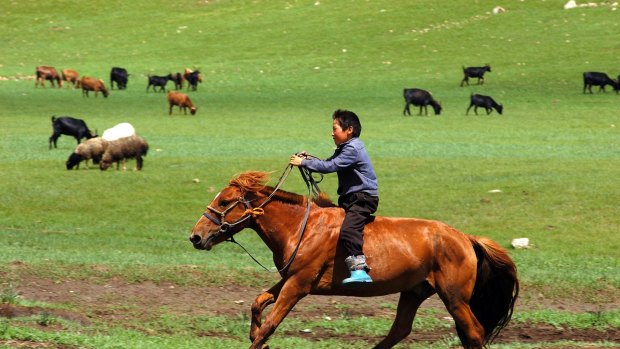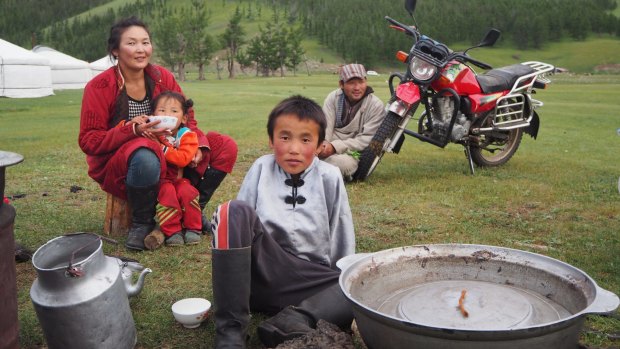This was published 8 years ago
A photography trip in Mongolia's Gobi Desert: Tips on better landscape photos
By Nina Karnikowski

Ger, Mongolia.Credit: Nina Karnikowski
It's not until I'm right in the thick of it, trekking through the lush green Eagle Valley in Mongolia's southern Gobi desert, that I realise the truth. I am a terrible photographer.
This comes as a shock. People had always told me my travel snaps were great, hadn't they? They'd had lots of likes on Facebook. That was why I'd invested in a small but capable camera earlier in the year. That was why, when the opportunity to spend 12 days on a photography trip travelling through the wilds of Mongolia with creative holiday company Frui arose, I jumped at it.
But now that I'm here, surrounded by a dozen of serious photographers holding cameras that weigh more than my suitcase, I'm suddenly acutely aware of how lacklustre my photos are compared with theirs, and how completely befuddled I am by words like "ISO", "shutter speed" and "aperture" that are being thrown around. As we hike across a brook, I fall into step with Simon Tupper, the blond-haired, blue-eyed English photography tutor who's travelling with us, and put it to him bluntly: why are my photos so terrible?

A shepherd tends his flock in Orkhon Valley, Ovorkhangai district, Mongolia.Credit: Alamy
"Don't worry," he says with a chuckle. "Mongolia's known for its epic landscapes but they can often end up looking flat and boring unless you add some foreground interest to give them a sense of scale." He helps me practise as we walk through rumpled fields upholstered with purple flowers, and I instantly notice a difference.
A picnic lunch awaits us at the end of the pass, and when we're done we jump into four cool-looking ex-Russian military vans – our transport for the next 10 days – and travel for a bumpy five hours across dozens of kilometres of steppe. En route we stop to photograph romantic vistas dotted with wild horses, herds of sheep and goats, and Bactrian camels with comically flaccid humps.
When we arrive in Khongoryn Els, we venture out to what are said to be some of Mongolia's most spectacular sand dunes to shoot their sculptural waves at sunset, before heading back to our ger (the Mongolian version of a yurt) camp for a vodka-soaked feast and slide show of the day's images – most of which look like they belong on the cover of National Geographic. I pretend to have accidentally erased my embarrassing shots off my memory card, and scuttle to my ger for the night.

Mongolian family.Credit: Nina Karnikowski
The next morning we rise early, brains a little bruised from the vodka, to ride a group of loping Bactrian camels across the dunes. It's exhilarating and uncomfortable but the real highlight comes when we return that afternoon to visit, in their ger, the nomadic family who own the camel herd.
Mongolia is a land steeped in rituals and etiquette, and it can be horribly easy to offend someone. So after a lesson on ger etiquette from our guides Tuya and Duuya (enter the ger with your right leg first; never ask a nomad how many animals are in his herd; never say thank you when you're offered food or drink since it embarrasses Mongolian people), we try our best to get things right and not to bring shame on our group.
We're offered yak cheese, airag (fermented mare's milk, an acquired taste), snuff and vodka, and learn to play the "finger game", the addictive Mongolian version of rock, paper, scissors. Afterwards we listen to the family, dressed in their traditional deel-embroidered tunics, sing haunting Mongolian folk songs, then politely ask if we can practise our portrait photography on them.
They're willing subjects, especially since we've now developed a relationship with them, which Tupper believes is the key to taking a good portrait shot. He shows us how to make sure our subjects are in the best light, and how to use the background of their ger and the camel-pocked landscape surrounding it to give the shot context.
We leave in awe of how overwhelmingly hospitable these nomads have been and decide that it shouldn't come as a surprise; pulling together and sharing is most likely the way they survive their incredibly long, harsh winters.
From here we drive east across the relentlessly arid steppe towards Bayanzag, stopping to hike a mountain covered with ancient rock carvings of horses mounted by fierce warriors, huge rams with curled horns and Bactrian camels. When we arrive at our ger camp for the evening, we take a quick archery lesson, pulling back the Mongolian composite bows and imagining what it must have been like to be one of Genghis Khan's fierce archers, before we're bundled back into the vans and driven to the Flaming Cliffs. Tupper gives us tips on how to adjust our ISO (which by now I understand is what controls how sensitive your camera is to light), and we practise shooting the monolithic red sandstone formations as they're set ablaze by the setting sun and hear tales of how the world's first dinosaur eggs were discovered here in the 1920s.
In true nomadic spirit, we're on the move again early the next morning, driving to the Ongiin Khiid temple complex in Central Mongolia. Before communism, the Mongolians were Buddhists and Shamanists but during the communist regime the Prime Minister Khorloogiin Choibalsan tried to suppress the faith, instigating the notorious purges that swept across Mongolia from the end of the 1930s. Thousands of Buddhist monks were killed and 800 monasteries destroyed, including Ongiin Khiid, formerly one of the largest monasteries in the country where more than 1000 lamas resided since its foundation in 1660. We head out to shoot it in the gentle afternoon light, and Tupper suggests we use our black-and-white settings.
"There are no real rules about when you should use black-and-white over colour, but it does make texture and surface appear more rich and scenes appear more moody," he says as we scramble through the area's crumbling ruins and past blue prayer flags as they bristle in the hot, dry wind. Looking at our group's images during our nightly post-dinner drinks and photography slide show (which I've finally started contributing to since realising what a fantastic learning opportunity they are), the results speak for themselves.
The most important lesson of our journey, however, comes that afternoon when we're stopped at a remote – and at first glance hideously unattractive – town for a couple of hours as our drivers refuel the vans. Rather than sitting on the kerb willing the time away, Tupper suggests we head out and take some shots that challenge Mongolian stereotypes.
"It's important not to perpetuate the myths of a destination so people don't get stuck in the cycle of producing postcard shots that don't represent the destination in its true essence," he says. And he's right. As I amble through the village, I photograph storm clouds gathered over a turquoise Soviet-era building, a local clad in a deel sleeping over his motorbike handlebars, and a tiny smooth-faced child in a Spiderman T-shirt playing in the dirt. They may not be the quintessential Mongolian images of a man atop a mountain with an eagle perched on his arm, but they're honest moments that speak about real life in this strange and beautiful land.
Close to 40 per cent of Mongolia's population still live as nomadic shepherds, and for the next two nights we're treated to an intimate insight into their lives as we head to the Orkhon Valley to stay with a nomadic family and their four children.
We arrive in the valley dotted with larch trees, yaks and wild horses, and are immediately set to work. First we help the family erect one of the gers they've borrowed from their neighbours for our stay, setting in place the door, central pillars and accordion-style walls, which we then cover in layers of sheep's felt and canvas. The result is simple yet cosy, and can all be packed back up again on a yak's back in one hour when the weather gets colder and the family move to their winter camp.
The following day we break up into small groups and help the family milk their mares to make cheese, clotted cream, airag and vodka from yak's milk, sew a tiny blue silk deel for their baby, and assist in the gruesome task of slaughtering a goat for dinner. We ride into the wilderness on their horses, and spend the evening drinking yak vodka and singing folk songs around a bonfire, before Tupper gives us a night photography lesson under a star-soaked sky. We leave feeling uplifted by the sense of happiness and tranquility that permeates everything in our nomadic hosts' lives.
Our arrival in the northern Orkhon Valley coincides with the Tsaidam naadam, or horse festival. There are 3.4 million horses in Mongolia for fewer than 3 million people, and Mongolian horsemen are known to be the most skilful, talented and resilient in the world. "We're born in the saddle, it's in our blood, probably because our mothers ride horses when they are pregnant with us," Tuya whispers to me as we watch kids as young as three race thundering horses bareback.
It's the perfect location for a lesson on the "decisive moment", a phrase the godfather of street photography Henri Cartier-Bresson used to express what photography does best – freeze a potent but fleeting moment for eternity. We shoot the kids as they race, the fascinating and mildly hilarious intermission of Mongolian men wrestling in turquoise underpants and cropped jackets, and the older deel-clad horsemen catching and riding wild horses using an urga (a kind of Mongolian lasso attached to a stick). I snap away gleefully at the men clutching the tangled manes of these glossy, wild beasts as they try to tame them, using their balance, strength and skill.
Our final evening in the Mongolian wilderness is spent at the vast and beautiful Ogii Lake. As the sun sets, I swim through the glassy waters and out towards the horizon, washing the dust from the naadam off my body and failing to remember a time when I'd felt so open and so free. And that evening, when it's time for show and tell, a sense of pride rather than embarrassment swells in my chest when my image of a horse rearing its glossy head up into the blue sky is flicked up on the projector.
TRIP NOTES
MORE INFORMATION
GETTING THERE
Air China flies from major Australian airports to Ulaanbaatar for around $2235 return. See airchina.com for details.
TOURING THERE
Frui's 14-day photography holiday to Mongolia costs $5900 per person. Includes accommodation in your own private ger tent, all meals, guides, transport, internal flights and expert photography tutor throughout. 2016 tour dates are July 15-28, and July 28-Aug 10. See frui.com.au for details.
The writer travelled courtesy of Frui holidays.
Sign up for the Traveller Deals newsletter
Get exclusive travel deals delivered straight to your inbox. Sign up now.